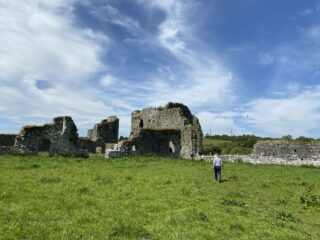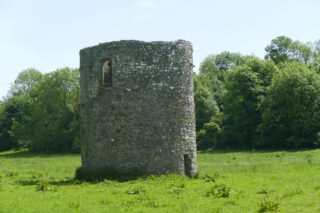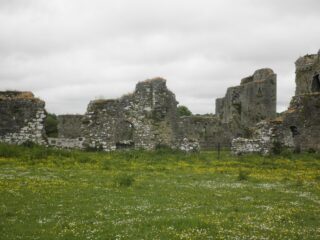Notice
Ballybeg Priory is a National Monument in state guardianship
WARNING: It should be noted that these sites are unguided and a level of care and caution should be maintained during all stages of your visit. The Office Of Public Works (OPW) will not be held responsible for any damages, injuries, or losses that occur
Ballybeg Augustinian Priory
Less than 2km south of Buttevant, stands Ballybeg Priory, dovecote and tower. The priory is an Augustinian Priory founded in 1229 by Philip de Barry, kinsman to the Barry’s of Barryscourt Castle, and dedicated to St Thomas Becket. It is one of only two substantial Augustinian monasteries in Cork, with Ballybeg initially granted just over two thousand acres which increased over the centuries.
A very wealthy monastic settlement, Ballybeg was dissolved in 1541 with the dissolution of the monasteries, under Henry VIII. The priory was in ruins by 1750, with much of the stone being used elsewhere in the locality. What is seen today are the ruins of the priory, its church, and claustral ranges. Remains of a sedilia and three stone-built burial chests are visible. In the late medieval period three towers and circular columbarium were built onto the priory.
Architectural features include, in the interior of the priory, a 13th century window with a banded shaft that bears a capital of foliage with three small human faces, two carved animal heads with mouths open (which functioned as rope-holes), and a carved human head on piers, which was typical of early English Gothic architecture.
The columbarium, or dovecot, is perfectly preserved and holds a continuous upward spiral of nesting boxes, 352 to be exact. The immense wealth of Ballybeg is long forgotten however to have had such a columbarium. Under medieval law, having one pigeon nest meant the owner had to have 1¼ acres.
The need for such an excess of pigeons was simply the waste they produced. This was used as fertilizer by the monks and seen as having higher economical value than that produced by any other animal.
Ballybeg tower, north of the Augustinian priory, is entered via a three-centred arch with the ground-floor chamber lit by a slit window in the north wall, and slit windows with double-splayed embrasures in the remaining three walls. The ceiling is a wicker vault, partially collapsed. The first floor shows traces of a garderobe chute. The tower dates to the medieval period and is believed to have formed part of a defence for the site.
Visit Historic Environment Viewer for more information on Ballybeg Priory
Protect our Past - Click here to read about the importance of protecting our country’s unique heritage sites
This national monument is protected in accordance with the National Monuments Acts 1930 to 2014
Gallery
Nearby sites to visit
Doneraile Court and Estate
North Cork’s ‘real-life Downton Abbey’
Approx. 5.9 km from Ballybeg Augustinian Priory
Annes Grove Gardens
A horticultural paradise in north Cork
Approx. 13.6 km from Ballybeg Augustinian Priory
Lough Gur Visitor Centre and Lakeshore Park
9,000 years of life
Approx. 35.2 km from Ballybeg Augustinian Priory
Desmond Castle Newcastlewest
Where sounds of medieval revelry echo around the walls
Approx. 37.0 km from Ballybeg Augustinian Priory
Adare Castle
Discover a medieval masterpiece, built for defence
Approx. 39.2 km from Ballybeg Augustinian Priory
Fota Arboretum and Gardens
Explore an island oasis of rare and exotic flora
Approx. 43.8 km from Ballybeg Augustinian Priory




